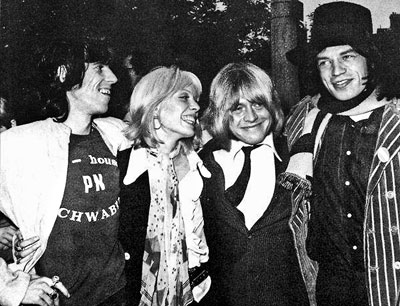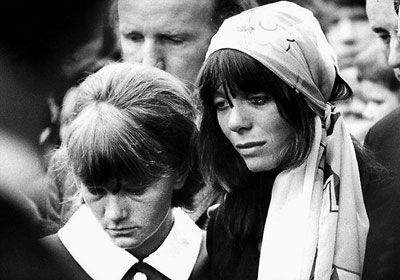A lone Rolling Stone in Ceylon

Keith Richards, Suki Potier, Brian Jones & Mick Jagger - September 26, 1968 (Courtesy Daily Mail Archive)
In the fading minutes of July 2, 1969, Brian Jones, 27, who founded and named The Rolling Stones, was seen motionless at the bottom of the swimming pool at his property, formerly owned by Winnie-the-Pooh creator AA Milne, in Sussex, England. Brian, a brilliant multi-instrumentalist sacked by the Stones a month before due to his estrangement from the band, had, surprisingly, been larking about in the pool with his builder Frank Thorogood, who had been sacked by him earlier in the day.
Brian, an asthmatic, asked guest Janet Lawson, a nurse and girlfriend of the Stones’ driver, Tom Keylock, to find his inhaler. During her long search for it in the house, Thorogood appeared in the kitchen “in a state” with “shaking hands” according to Lawson, who, fearing the worst, ran to the pool where she witnessed Brian’s predicament. She shouted to Thorogood for help, which he initially ignored. Only later did he dive into the pool. When Jones was fetched from the depths, it is said he had a weak pulse.
Police Constable Albert Evans arrived at the scene, known as Cotchford Farm, at 12.10 a.m. on July 3. Shortly after, ambulance crews tried to resuscitate Brian but he was pronounced dead. Officially, he drowned while under the influence of drink and drugs: a verdict of death by misadventure was recorded at his inquest. But since then, theories have circulated regarding Brian’s death, most focusing on Thorogood, who died in November 1993.
Two books appeared the next year claiming he murdered Brian, Paint It Black: The Murder of Brian Jones by Geoffrey Giuliano and Who Killed Christopher Robin? by Terry Rawlings. The former title refers to a 1966 Stones hit, the latter to AA Milne, for his son Christopher Robin is a prominent character in his 1920s pair of Winnie-the-Pooh books.
Paint it Black was dramatised as the film Stoned (2005), known as The Wild and Wycked World of Brian Jones in the UK, a cult classic and the sole cinematic biography of the Stones. It was directed by Stephen Woolley (producer of the Oscar-winning The Crying Game) and the part of ‘wycked’ Brian was played by Leo Gregory (of Need for Speed video game fame).
Then, in the (London) Mail on Sunday, November 29, 2008, investigative journalist Scott Jones claimed he had gathered enough new evidence for the investigation to be reopened, accusing senior police officers of covering up the true cause of death. Indeed in August 2009, Sussex Police decided to review his death but the decision was made not to reopen the case.
Scott Jones had traced most of the guests at Cotchford Farm on the night of the tragedy, the retired police officers concerned, and unseen police files at the (London) National Archives. What he found was alarming.
PC Evans, retired, said that there were more people around than the three witnesses represented in the police file. Janet Lawson repudiated her police statement claiming that the policeman suggested most of it. (Lawson’s comments quoted earlier regarding Thorogood were made to Scott Jones.) Another witness had been sedated by her doctor and had to be continually woken during the making of the statement.
Thorogood was in possession of a quantity of drugs but only cautioned. Most damningly, Scott Jones read in the unseen files that a few weeks after Brian’s death Thorogood was the main suspect in an horrific attack on his lover, Joan Fitzsimons, which blinded her. Two dubious friends gave alibis so he was eliminated from the inquiry. The victim’s Jordanian boyfriend was jailed, loudly protesting his innocence.
“Having spent two years studying the evidence and speaking to most of the surviving players, I am convinced Brian Jones’s death was not fully investigated,” Scott Jones concludes. “The only question that remains is why? I hope this is something the authorities will discover if they finally decide to reopen the case. It is the least Brian Jones deserves.”
Where morbid rock history is concerned, Brian was one of the first members of the “27 Club”. There were a few others before him, such as Ruby Lewis of The Drifters, but Brian was the first of the big stars, quickly followed by Jimi Hendrix, Janis Joplin and Jim Morrison of the Doors, who all died at the age of 27 between 1969 and 1971. There have been an astonishing number since, most notably Kurt Cobain and Amy Winehouse.
Brian Jones’ death may seem irrelevant to Sri Lanka, but in his last year of life or so he turned to the Island for respite and solace after being ostracised by the Stones; making visits once, probably twice and even perhaps thrice during 1968 and early 1969 on the recommendation of his buddy, Emilio “Mim” Scala.
In 1963 Mim co-founded with Sir William Piggott-Brown the London-based television, film, theatrical and music agency, Scala Brown Associates. Actors represented included Christopher Plummer and Richard Harris, and musician Cat Stevens. In 1967 Mike Wilson, friend of Arthur C. Clarke, diver and director of Ran Muthu Duwa (1962), Getawarayo (1964) and Sorungeth Soru (1967) – aka “Jamis Banda” – invited Mim to meet him at the Park Lane Hilton in London during his attempt to persuade Columbia to finance Satyajit Ray’s “The Alien” project.
Mim, in his personal history of this splendid era, Diary of a Teddy Boy: A Memoir of the Long Sixties (2000), relates: “The lift opened into the penthouse suite. There was a bearded figure with a ponytail and pirate thigh-high boots, standing in the semi-darkness. He told me he had heard I was a very good agent.”(See “Story of a ‘might-have-been’: Satyajit Ray’s ill-fated science-fiction project, The Alien”, The Sunday Times, September 27, 2015.)
Mim called Mike in due course to discover the fate of the project: “It’s too far out, man. They’re not ready for this kind of movie. But thanks for your help. If you ever want a beautiful holiday, come and visit us in Ceylon.” Which Mim did (see “Hikkaduwa: Scenes from the Sixties”, The Sunday Times, August 1, 2010.) I met Mim on a subsequent visit in January 1973 at Hikkaduwa in Mike’s company.
In May 1967 Brian had been arrested for possession of marijuana, convicted, and sentenced to nine months’ imprisonment. “The sentence was handed down despite a psychiatrist’s evidence that Jones’ mental health would be completely destroyed by confinement,” reports Rolling Stone, November 23, 1967. “He would go into psychotic depression as he could not possibly stand the stigma of a prison sentence, and he might well attempt to injure himself,’ argued Dr Leonard Henry, who treated Jones for a breakdown after his arrest.”
Mim agreed: “This was a tragedy that Brian was in no mental condition to handle, as the letters I was to receive from him would prove.” Mim tells me he is pretty certain that when Brian was released in December, he suggested his friend make course for fabled Serendib to stay with the enigmatic Mike Wilson, and heal sufficiently to resume his career as a musician away from the Stones.
I knew Mike – Swami Siva Kalki from this point – from 1973 to his death in 1995 – and he had briefly mentioned Brian’s visit or visits. Regrettably I never recorded his detailed ‘Brian Jones story’ as I had with “The Alien” project. So the part of this article set in then Ceylon is largely based on the memory of Mike’s eldest daughter, Damini.
According to Damini, her father drove to Katunayake to pick up Brian in their orange VW camper van; a classic vehicle maybe, but a far cry from Jones’ chauffeur-driven Bentley in England. Another difference was that unlike in England and elsewhere his arrival with girlfriend Suki Potier was not greeted by the Press. This was a secret trip. And naturally he went unrecognised in Serendib.
Mike brought his guests to his residence, 33, Amarasekera Mawatha, Colombo 5, now a popular Chinese restaurant. They gave Damini and younger sister Yasmin Barbie dolls, which were still a relative novelty in the West but unknown in Ceylon. A “sackful” of imported chocolate was gifted, too.
Rather than embrace their exotic environment, Brian and Suki chose to shut out the world by taping the windows of their room with black paper. Moreover they never emerged from the house during their stay, possibly a fortnight thinks Damini, though there was much interaction with the Wilson family and its entourage.

Barbara Jones & Suki Potier - July 10, 1969. Brian's funeral (Courtesy Rue des Archives)
John Chang was the head cook and there were several assistants. While Eastern dishes were prepared for most of the household, Suki advised how Brian’s Western diet – actually very British, centred on steak and kidney pie and pork pie – could be satisfied. Mim notes, “His diet [seemed] to consist solely of pork pies, which his faithful driver would deliver with the obligatory bottle of HP sauce”.
Suki was a leading model of the time, mainly for celebrated designer Ossie Clark. “She was a quiet, mysterious girl” Mim comments. She had survived unscathed a car crash in 1966 in which the young London socialite. Tara Browne, heir to the Guinness fortune, was killed. It was this tragedy that led her to Brian: “He gave me a shoulder to cry on and he picked up the pieces and made me feel a woman again.”
She was the longest-lasting (‘67 to ‘69) of Brian’s many transnational girlfriends. Others included the Italian-born actress and model, Anita Pallenberg, best-known for her role alongside Mick Jagger in Nicolas Roeg’s Performance (1970), who left Brian for Keith Richards; French actress Zouzou, who starred in Eric Rohmer’s acclaimed Love in the Afternoon (1972); mysterious Amanda Lear, probably born in Hong Kong, model and muse of Salvador Dali; and the Berlin-born singer and songwriter Nico, an early member of The Velvet Underground.
Suki, who was at Cotchford Farm until 30 minutes before Brian’s demise (another witness not contacted by police) was just 21 and so devastated that the soon-to-be-assaulted Joan Fitzsimons stayed with her at the farm for three days. Suki married the son of a Chinese billionaire but sadly her luck in bad car crashes ended in 1981 when at 33 she was killed alongside her husband.
When Brian visited Ceylon he had already viewed AA Milne’s 16th-century Cotchford Farm but was undecided whether to purchase it or not. It was customary for Mike to read Winnie-the-Pooh (1926) and The House at Pooh Corner (1928) to the girls, using different voices for different characters. If Chris Greet happened to be at No. 33, as he often was, he would join in.
It must have been a hell of a performance. I rate Chris the most idiosyncratic ‘Anglicised’ actor Sri Lanka has produced, employed to inventive effect in British TV productions two decades ago. In Manik Sandrasagra’s Rampage (1977), for which I wrote Chris’ part with him specifically in mind, he outshines co-star Gamini Fonseka, who had received the same treatment.
After Brian heard the tales of Winnie-the-Pooh courtesy of Mike – and perhaps Chris, who did visit during Brian’s stay – and viewed EH Shepherd’s inspired illustrations, he was convinced he should buy Cotchford Farm. What’s more, for making him understand the intrinsic value of the property, he promised to “put it in our names” says Damini, referring to sister Yasmin, but this never happened probably due to Brian’s looming death.
I don’t know how much Brian paid for the farm in November 1968. Coincidence always lurks: Cotchford Farm was for sale in March 2016, perhaps still is, for £1.9 million due to its literary and rock history. The month of sale is of more interest as it helps in guesstimating the time of Brian’s supposed visits.
************

Cotchford Farm and the fateful swimming pool
Early 1968 is a likely period for Brian’s first Ceylon visit for the reasons given by Mim (“to chill out” as he told me), and because mid-year and beyond the ‘Stone Alone’ was busy. In May and June he was involved, though peripherally, in the making of Jean-Luc Godard’s Sympathy for the Devil, or One Plus One (1968), an extraordinary “deconstruction of the myth of the genius creator” I remember well, being a Godard fan in my film student days. Mim played a huge role in putting the project together. “The Rolling Stones as a band were still film virgins” he declared.
The last day of shooting was June 4 to record the Stones’ “Sympathy for the Devil”. Mim arrived at the studio with Brian. “He was not in good shape. He had had a row with Mick and Keith. I really felt for him. He was on his own.” After the recording Mim could tell Brian was not happy. “He felt that he had not contributed to the track. It is possible that he was not even plugged in. ‘Get me out of here, Mim,’ Brian said.”
Wikipedia believes that in the film “The dissolution of Stone Brian Jones is vividly portrayed.” Mim reminisces: “I felt an enormous sadness for Brian at this time. He was getting more and more screwed: by the Stones, by the drugs, by his own paranoia.”
Yet weeks later Brian travelled to Morocco with Suki to record the Master Musicians of Joujouka on July 29, released after his death as Brian Jones Presents the Pipes of Pan at Joujouka (1971), which promptly joined my LP collection. Brian called the tracks “a specially chosen representation” of music played in the village during the annual Rites of Pan Festival.
Mim believes Brian returned to Ceylon in late 1968 with an as yet unmentioned partner, Linda Keith. Former girlfriend of Keith Richards, Linda listened to Jimi Hendrix in New York in 1966 and managed to get him a contract in London. (Watch John Ridley’s Jimi: All is by my Side (2014), although some say don’t believe all.) Linda had a short, “mad affair” with Brian that ended with an unsuccessful suicide attempt.
Damini distinctly remembers a second visit, but she maintains Brian was solo. Mim suggests a third visit, perhaps Brian solo, maybe the one Damini refers to. If these visits did occur they were probably made in late 1968 or early 1969 after he acquired Cotchford Farm.
To conclude, I hunted through obituaries for some golden nugget that encapsulates Brian’s contribution to rock history and the essence of the personality that lead to his demise within the band he founded, masked by the Jagger/Richards takeover. Appropriately it is Mim who I believe provides the shrewdest comment:
“This was the guy who a year before was strutting the world as a psychedelic superstar with his friend and wizard Jimi Hendrix at his side. On the street these two were more powerful then Keith [Richards] and Mick [Jagger], or John [Lennon] and Paul [McCartney] . . . Brian and Jimi transcended business. They were the embodiment of the Pan-like minstrel from any age, even more so when they were dying. Sure, we are all dying, but they were doing it with a little more urgency.”


